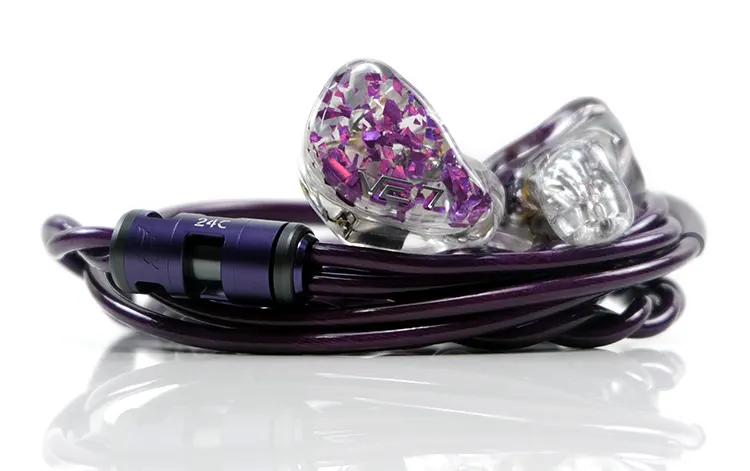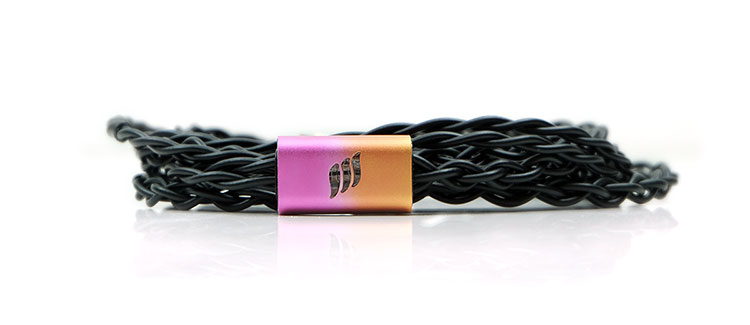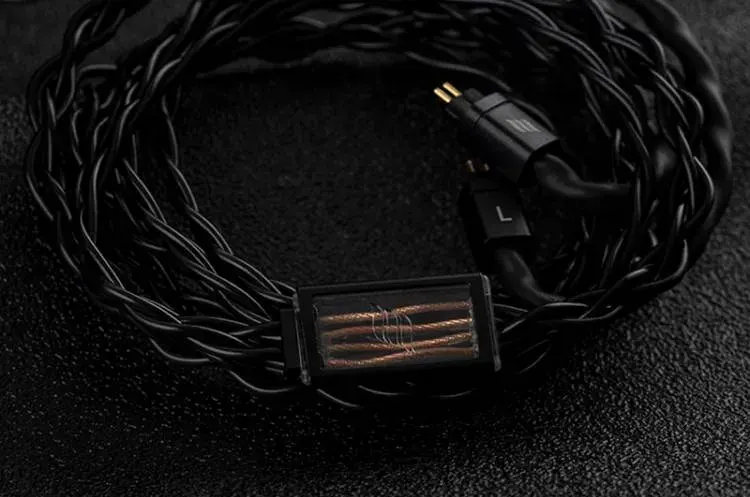Synergy
These cables pulled me in a few directions when it came to IEM pairings. There was not so much a specific divide as in this IEM works better with that cable rather aspects of this IEM I prefer with that cable when listening to this type of music.
Code 24
For example, Code 24 adores dynamic driver hybrids, especially those tuned with a level of aggression and power in the lows.
Now both cables do fatten the bass of monitors such as the 64 Audio U4S noticeably but that additional definition and slightly cleaner tone of the flagship Code 24 tightened up the lows notably over the warmer but softer 24C Limited performance.
Impact and dynamism belong to Code 24 so, monitors such as the Vision Ears EXT, Empire Ears Odin, and the Noble Audio Kublai Khan all will deliver a higher level of energy from their dynamic drivers.
If you are an EDM or an R’n’B lover then it also will give you a stronger fundamental to lower register instruments more suitable to maximizing the bass performance of the aforementioned monitors.
It is also a better pairing for IEMs that resolve well within a spacious soundstage. Big-sounding monitors such as the Viking Ragnar and the Ronin do better with the more holographic and dynamic-sounding Code 24 over the Limited Edition’s more muted set of highs and generally more intimate presentation.
You can hear more treble influence and detail from the above pairings and it does make a difference in terms of noticeable headroom and higher-pitching instrumental definition and presence.
Code 24C Limited
If you prefer softer melodies, less bass intensive perhaps, and more of a focus on breathy mixed vocals with less instrumental layering behind, then Code 24C Limited brings more to the table with some monitors.
For example, Odin’s mid-forward performance gelled very nicely with the smoother, warmer delivery of the Code 24C Limited pairing.
This cable’s closer vocal imaging and softer treble performance made this pairing ideal for vocal performances. The likes of Dominique Fils-Aime, Barbara Weldens, and Brittany Howard, all of whom are breathy soulful vocalists, often with stripped-down backing tracks, have a beautiful fulsome vocal timbre from this pairing.
I would say there is also an argument for brighter monitors pairing well with the 24C Limited if you intend to soften up any sharpness from the upper mids and lower treble of IEMs.
For example, the Ragnar can inch a little more to the softer side on the highs with the Limited though the shift is not huge, or not as huge as I would like would be the more accurate statement.
Select Comparisons
The following comparisons were completed using a mixture of the Vision Ears EXT, Noble Audio’s Ronin, 64 Audio’s U4S, and the InEar ProMission X combined with the HiBy R8 II as the main source.
Effect Audio EVO 10
The Effect Audio EVO 10 was launched in early 2021 with our review coming out not long after in March of 2021. The EVO 10 price point is between the Code Series cable prices but for this review, we will compare it to the flagship Code 24 cable.
Technical
Copper is at the heart of these two cables but the mix of metals, gauge size, and geometry are massively different.
The EVO 10 is a mix of materials though not an alloy with the use of both 26AWG UP-OCC Gold-Plated Copper and UP-OCC Silver-Plated Copper. This is a 4-wire design but wires are separated with individual strands of copper and silver rolled as one rather than 2 wires of copper and 2 wires of SPC.
Code 24 keeps it simpler with UP-OCC silver-plated copper Litz wire throughout but with a much bigger 16.5AWG gauge and a vastly more complex geometry. Instead of EA’s more traditional 7-core bundled Litz geometry, we have a Trio-Flex™ Pure Solid Core System and 13 multi-sized core bundles.
One last thing to note. The EVO 10 uses additional Surlyn insulation material whereas Code 24 uses standard UltraFlexi Insulation only. Perhaps the geometry complexity makes it physically impossible.
Design
I guess that the genesis of EA’s dalliances with barrel cutaways started with the EVO series. Certainly, the EVO 10, (and the 1), were the first cables that I can remember that allowed you to ‘peer’ inside the jacket to see the actual cables via a Perspex window on the splitter.
Now with Code 24, you do not get quite the same perspective but the splitter is cutaway with that Timascus finish inside giving it a bit of additional visual pop.
I would consider this a refinement of the EVO 10 thinking with a higher grade finish on the barrel though the changeable splitter plates on the EVO 10 do add a bit of ‘fun’ to your cable’s color theme.
Beyond the intricacies of the splitter, Code 24 is a massive cable compared to what I would guess you could call a standard aftermarket cable size for the EVO 10. It is thicker and heavier though both are of the same length.
The handling will be very different though both perform well in terms of low memory retention. You will feel the additional presence from Code 24 when using them with IEMs though the surface contact is smaller for both IEMs so it’s more about the downward pressure generated by the heavier Code 24.
Because Code 24 is bigger and uses a mix of gold accents, larger barrels, and a solid blue jacket the design really stands out.
Despite the EVO 10 having the ability to change plates it still looks relatively low profile compared to the Code 24 eye-candy. It also lacks a Chin cinch which Code 24 not only offers but comes with some serious styling.
Performance
The technical leap from EVO 10 to Code 24 is significant. You get improved dynamics, more loudness when volume matched, and a better level of note separation, particularly in the center imaging of the two tested IEMs.
For both the Ronin and the 64 Audio U4S, the depth, note density, and vocal clarity were much better with Code 24. Within each note, nuanced reflections, textured detail, and definition took a significant step upward when compared to the EVO10 performance with the same IEMs.
Code 24 delivers a meatier sound from top to bottom and though tonally they do not stray that far from each other in how they color the timbre of instruments and vocals with each IEM I do feel that Code 24 delivers a slightly more natural smoother tone.
Evo 10 teases out a little more energy from the upper mids and lower treble percussion passages but perhaps that’s psychoacoustic at play there because the bass weight and richness were not quite as bombastic or as warm when swapping over to Code 24.
That tended to let the mids and treble come to the fore a bit more with both IEMs when paired with EVO 10 but even then the clarity and space around both vocal and instrument sounded relatively compressed and shrunken.
No question Code 24 has the more immersive holographic soundstage with both IEMs. You get improved depth, especially with the U4S and vocals just a shade further forward on both, stretching the stage front to back. EVO 10 sounds relatively compressed and less dynamic in its presentation.
Effect Audio Leonidas II
The Effect Audio Leonidas II is a long-standing classic of the Heritage Series. Launch in 2018 and reviewed by us that same year, it is the smaller sibling to the OCTA version and slightly higher in price than Code 24.
Technical
The Leonidas II leans more to the exotic end in terms of wire metals. This is a UP-OCC palladium-plated silver & Litz silver hybrid wire as opposed to UP-OCC silver-plated copper Litz.
Though a much smaller gauge compared to Code 24’s 16.5AWG the choice of metals is more on the expensive side which is where I presume a lot of that additional cost comes from.
The geometry of the Leonidas II is classic EA. This is a 4-wire build, 26AWG wire gauge, using a 7-core bundled Litz-type configuration which is a geometry used in a lot of their cables since then.
I do believe, however, that it was the first of their cables to use the Golden Ratio formula for resonance reduction from the use of different types of strands.
Code 24’s Trio-Flex™ Pure Solid Core System and 13 multi-sized core bundles make this a more ambitious build despite its relatively lower price point. It also makes it the bigger of the two cables.
Design
I have always loved the Leonidas II design. Even the OCTA version looks great and at times I often think the thicker one handles a bit better. My personal preference is for a little bit of weight just to prevent that flyaway effect in a cable that can end up catching onto things and causing unintended damage.
Still, if you want weight then Code 24 is going to overshadow the humble size of the Leonidas II in a very serious way. 4-wire 26AWG is light as a feather compared to the multi-core 16.5AWG monster so if you are after discretion then the Leonidas II does a better job of it.
Due to its smaller size and lighter nature, the Leonidas II cable should be generally easier on the ears. However, it’s not quite a home run.
Sure, the weight is heavier, but the Code 24 jacket is softer. Leonidas II uses an older PVC mix that got stiff over time and where there is contact with the ear I found the PVC from Code 24 more comfortable.
Design is always in the eye of the beholder and I think both look spot on for different reasons. No question Code 24 is the more modern design, the more elaborate, and with the solid blue jacket, gold accents, and Timascus finishing, the more eye-catching.
However, there is something more ‘gentlemanly’, more organic, or natural in the off-white hue of the Leonidas II cable combined with that lovely patina leather finish on the super light barrels. It is a classic EA look with those older chrome barrel connectors and lacks a ConX connector system.
Performance
Two very different ‘tools’ here, to be honest. Code 24 is all about power, weight, sparkle, and vocal immediacy. It’s the more explosive of the two cables allowing that excellent sub-bass presence from the 64 Audio U4S tuning to shine.
The Leonidas II is more relaxed in its delivery, it’s not as weighty, perhaps not as dynamic either but it spreads everything out wider, operates a bit better, and does ‘magical things’ with midrange instrumental and vocal separation.
Of the two cables, the Leonidas II is the better match with more spacious and resolving IEMs such as the Ronin which is less about power and more about precision and soundstage openness.
Code 24 is much more suited to maximizing monitors that trademark in-depth and power with a secondary nod to fulsome midrange vocal tones. It’s not quite as expansive through the mids as the Leonidas II and delivers a comparatively narrower staging quality through the same region on both IEMs.
Both IEMs move more towards the warmer side with both of the paired IEMs. However, the Leonidas II sounds purer or smoother, almost organic with the Ronin whereas with the same pairing, Code 24 has a little more contrast and denser tonal quality courtesy of that stronger bass quality.
One final note, there is a slight loudness difference between both with the tested IEMs. Code 24 is a bit more dynamic sounding when volume matched with Leonidas II needing a bit more gain to achieve a similar perceived loudness.
Effect Audio EVO 1
The EVO 1 was launched at the same time as the EVO 10 in early 2021 and is the junior of the two in the EVO series. Its price point is much closer to the Code 24C Limited making it a relatively fair comparison.
Technical
It is the battle of the two baby brothers, Junior versus Junior. To be honest, the EVO 1 doesn’t change a whole lot from the EVO 10, and thus you could say it is a more conservative wire geometry and sizing when pitched against the Code 24C Limited.
The EVO 1 does mix it up a bit more in terms of wire blends with a mix of UP-OCC gold-plated copper, UP-OCC silver-plated copper, and oxygen-free copper compared to 100% UP-OCC copper Litz inside the newer Limited.
However, it’s the geometry and gauge size that sets these cables apart internally. Both are selling side by side still but the concept of Code 24C Limited’s geometry just feels a lot fresher and more ambitious.
You are talking about a 4-wire 26AWG versus a much bigger 2-wire 18.5AWG gauge. We also have that inner Trio-Flex™ Pure Solid Core System surrounded by no less than 17 multi-sized core bundles versus the classic 7-core geometry of the EVO 1.
Like the EVO 10, the EVO 1 also uses Surlyn Insulation & EA UltraFlexi Insulation whereas the Code 24C Limited uses UltraFlexi Insulation only. Not something the everyday user is going to get too bothered about.
Design
Granted, Code 24C Limited is smaller and lighter compared to its flagship brother with that reduced 18.5AWG wire gauge.
However, even with that reduction, it is still by far the heavier and thicker of the two cables when placed side by side with the EVO 1. If you crave something lighter on your ear or in your pocket and something that can roll tightly then pick the EVO 1.
I much prefer the Code 24C Limited design though. It just feels like its EVO series ‘evolved’ with the crazy cool solid purple over solid black, the more elaborated cutaways on the barrels, the firmer accents, and the additional smoothly articulating chin cinch.
There will be some that will still prefer the lower profile of the EVO 1 and the ability to swap those faceplates when out and about. However, if you have a purple shell IEM like the Vision Ears EXT then the Limited combo is going to catch many an admiring eye.
Connection options are much the same for both cables. You can use ConX and TermX on either or just pick a single-choice balanced or single-ended plug.
HiBy R8 II owners take note, using the TPU case with the Evo 1 is not an issue for fitting the slimline barrel 4.4mm plug. With Code 24C Limited you can just about manage it, with Code 24 Flagship it is a no-go.
Performance
Both the Limited and EVO 1 are heading in the same direction with a warmer more colorful presentation with our two tested monitors, the Vision Ears EXT and the ProMission X from InEar.
However, the 24C Limited is a big step up, much like the EVO 10 and flagship Code 24 comparison. For a start the dynamic range is superior and the level of perceived volume higher with Code 24C Limited. The gap is not as big as the flagship shoutout but it is there and noticeable.
More so when the bass is called upon, especially with the EXT. Once that kicks in then the power and sub-bass presence take front and center with more impact, more rumble, and better detail. The EVO 1 does well in this area also but it’s slightly softer, less impactful, and with a reduced perception of sub-bass explosiveness from the EXT.
It’s a similar story with the mids and highs from Code 24C Limited when testing with the ProMission X. You get a step up in clarity and space with vocals sounding more vivid and less congested compared to the EVO 1.
Now both bring the vocal forward so their imaging is close to you the listener but the EVO 1 does less well in keeping a clear distance between the vocal imaging and surrounding instruments.
The ProMission X and the larger gauged Code 24C Limited combo did offer more headroom and better treble resolution which I think made a bit of a difference with staging and hence the lack of comparative congestion through the mids.
Our Verdict
Effect Audio Code 24 and 24C Limited are some serious power plays for the middle ground of high-performance cables without the super high prices to go along with them.
Granted, the weight and size will put off those who value a discreet and lightweight aftermarket cable but there is no denying that they are beautifully crafted and can look gorgeous with color-coordinated IEMs.
However, all that would be for nothing if they didn’t have a pleasing effect on those IEM’s performance and this is where both of these cables genuinely surprised me.
I am not sure how EA is squeezing in such large gauge cables for these new more competitive prices but I encourage them to continue with this metallurgical origami magic. They are both a clear step up in quality over many of their similarly priced older cables.
Having a choice is good. You can pick between dynamic and vibrant, weighty and smooth, or aesthetically, a striking purple or blue with gold accents. Either one will give you a very satisfying performance with the right IEM and listening preference.
Effect Audio Code 24 Specifications
- Selected Premium UP-OCC Silver-Plated Copper Litz
- Trio-Flex™ Pure Solid Core System
- 13 Multi-sized Core Bundles
- Proprietary Multi-size Strands Blend
- 16.5 AWG 2 Wires
- EA UltraFlexi™ Insulation
- ConX® & TermX™ Basic Sets Interchangeable Connector/Plug System (IEM Version)
Effect Audio Code 24C Limited Specifications
- Selected Premium UP-OCC Copper Litz
- Trio-FlexTM Pure Solid Core System
- 17 Multi-sized Core Bundles
- Proprietary Multi-size Strands Blend
- 18.5 AWG 2 Wires
- EA UltraFlexiTM Insulation
- ConX® & TermXTM Basic Sets Interchangeable Connector/Plug System







